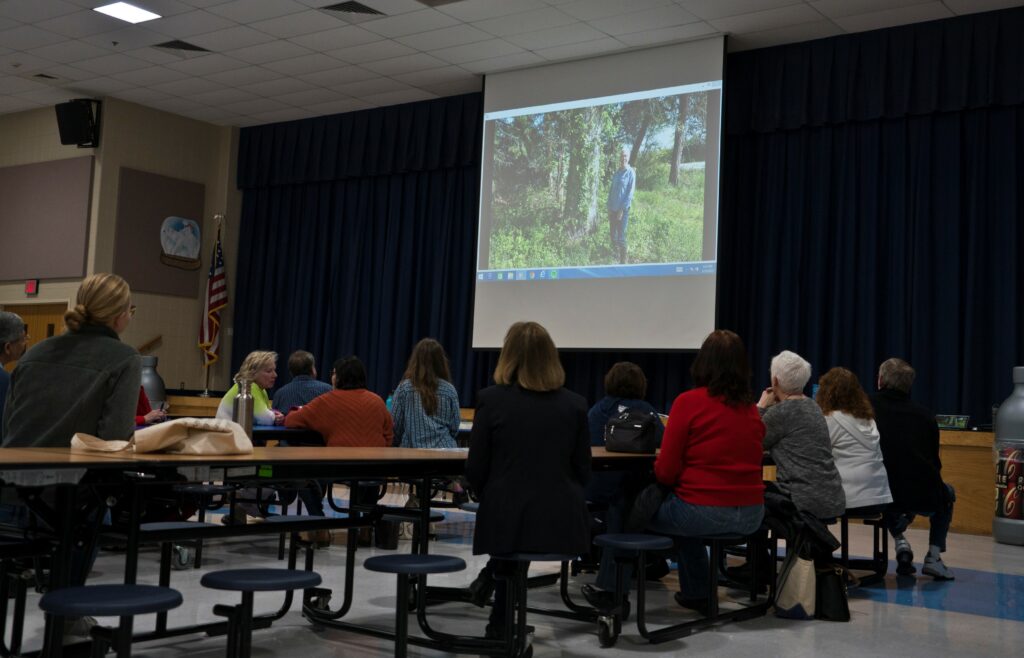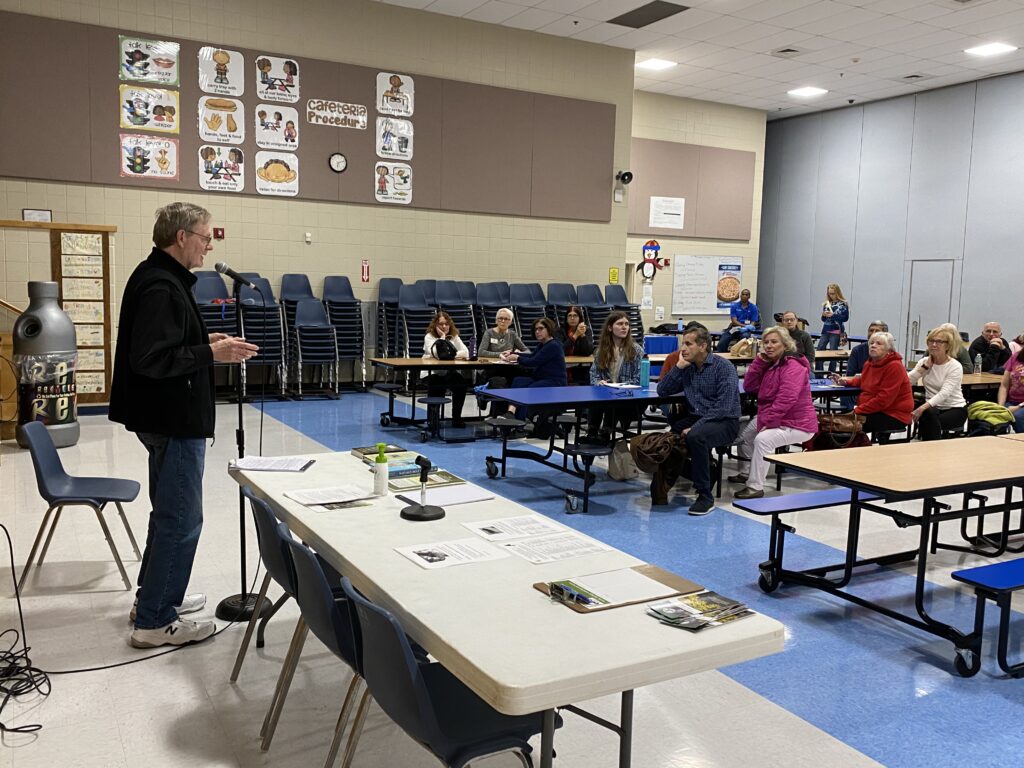Steve Jasiecki/From left, Barbara Fiedler, Jessie Connor and Stephen Fieldler speak about invasive species during a film preview at the William H. Ross School in Margate, Tuesday, March 10.
By NANETTE LoBIONDO GALLOWAY
MARGATE Approximately 25 people attended a program at the William H. Ross School Tuesday, March 10 to learn about invasive plant species that can crowd out native vegetation and change the area's biodiversity.
Attendees viewed a new video created by the Galloway Township Environmental Commission about non-native plants that are so common they grow along roadways, in parks, fields and in many backyards.
The film, 12 Tenacious Invasives, discusses just one dozen of thousands of non-native species that have been brought to the United States as ornamentals. However, their proliferation often crowds out, smothers or kills native plants that are beneficial to pollinators, such as bees and butterflies.
Of the 3,300 invasive species in our area, it was hard to find just 12. They have come to the U.S. from other areas for hundreds of years, said Project Manager Stephen Fiedler, who chairs Galloway Township's Environmental Commission and is a member of the Native Plant Society of NJ Southeast Chapter, which meets monthly at Stockton University.
 The film was produced by his brother, Mark Fiedler, who is currently filming another video on the Friends Along the Mullica River project, which involves all the municipalities along the Mullica, from Hammonton to Absecon, and Atlantic City.
The film was produced by his brother, Mark Fiedler, who is currently filming another video on the Friends Along the Mullica River project, which involves all the municipalities along the Mullica, from Hammonton to Absecon, and Atlantic City.
Fiedler said the film, which was funded with a grant from the Association of New Jersey Environmental Commissions, was made to be a conversation starter about how to protect the area's biodiversity, which is being lost to invasive species.
We are not contributing to help connect the dots between the two and need to look at our own backyards as mini-parks. We must all be part of the solution, instead of the problem, he said.
According to native plant expert Jessie Connor, invasive species cause monocultures that crowd out natives. She is featured in the film showing 12 common non-natives that can be found all over the township and in other areas.
The film is meant to educate the public, allow them to recognize non-natives and do what they can to prevent the proliferation of monocultures.
She discusses the problems created by plants commonly found at big box stores and garden centers, such as Japanese barberry, Asian bittersweet, English ivy, Chinese and Japanese wisteria, mugwort, Japanese honeysuckle, multiflora rose and autumn olive. Invasive tree species include the Tree of Heaven, the host tree for the dreaded Spotted Lanternfly, the Norway maple and the Bradford or Callery pear tree.
Most non-natives proliferate rapidly, sending out roots or rhizomes beneath the soil, seeds blow in the wind or are dropped by birds.
You should think twice about purchasing some of these plants, and consider removing them from your yard, she said.
The best solution for home gardeners is to buy from native plant nurseries or request native plants species at local garden centers.
We learned that people plant things to make themselves happy, she said, but more attention needs to be paid to making the birds, bees, flora and fauna happy.
 There is no benefit to planting crepe myrtles, Bradford pears, and exotic plant species, and residents should consider planting native plants, such as common milkweed that feeds and provides a place for the monarch butterflies to lay their eggs.
There is no benefit to planting crepe myrtles, Bradford pears, and exotic plant species, and residents should consider planting native plants, such as common milkweed that feeds and provides a place for the monarch butterflies to lay their eggs.
There are alternatives that will ensure a sustainable landscape, she said.
After the film, Connor recommended hand-digging to rid home gardens of invasive species. Other techniques, such as solarizing, or covering a hand-dug area with heavy plastic where the sun can bake the roots for a few weeks, can help rid the landscape of harmful plants. But the plastic should be removed after a few weeks because it could contaminate soil when the plastic degrades. It was also recommended that native home gardens be cleaned up in spring instead of fall because the plantings provide nourishment for birds during the winter months.
Sustainable Margate Chairman Steve Jasiecki, who arranged for the learning session, recommended Downbeach residents visit the native plant garden located on the Vendome Avenue side of the Margate Municipal Building on Winchester Avenue to see how they grow.
The demonstration garden was planted three years ago to show local homeowners the best natives to plant in their home gardens. It is maintained by volunteers and includes plants that nourish the flora and fauna of the shore.
For more information about planting native species, see npsnj.org, or https://blogs.stockton.edu/sjbfs/
Copyright Mediawize, LLC 2020